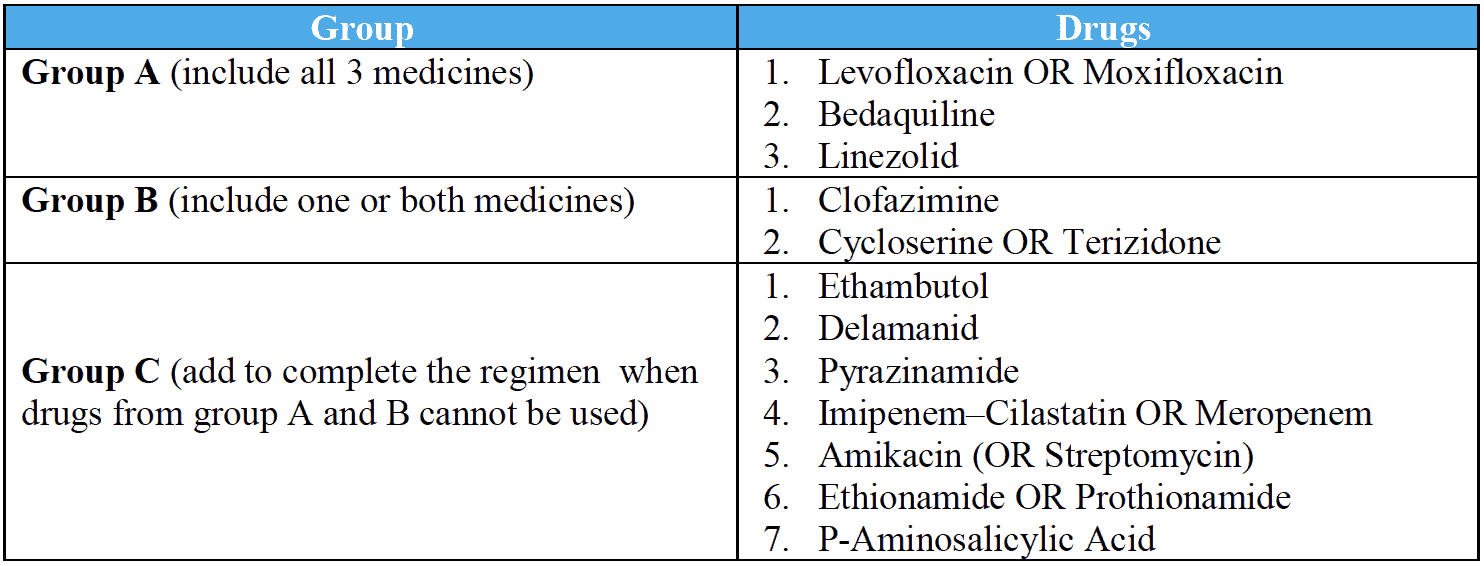MDR/RR-TB patients who have not been previously treated for more than 1 month with second-line anti TB medicines used in the shorter MDR-TB regimen or in whom resistance to fluoroquinolones has been excluded by SL-DST/LPA, the recommended shorter MDR-TB regimen is largely standardized. This is a daily regimen of 9–11 months with an intensive phase of 4 to 6 months, followed by a continuation phase of a fixed duration of 5 months.
Eligibility for STR:
The following MDR/RR-TB patients, with confirmed resistance to at least rifampicin, are eligible:
- No documented or suspected resistance to any of the medicines in the shorter regimen (except isoniazid resistance)
- No prior exposure to any of the medicines in the shorter regimen for more than 1 month. However, patients with an exposure of more than a month can be considered if there is documented evidence showing effectiveness of the drugs on a DST.
- The patient should not be suffering from extensive TB or severe extra-pulmonary TB
- The patient should not be pregnant.
- Only children aged 6 years and above are eligible.
Regimen and duration of treatment:
The shorter all-oral Bedaquiline containing MDR/RR-TB regimen is given in 2 phases as under:
- Intensive Phase (4 – 6 months): The IP contains 7 drugs, namely, bedaquiline, levofloxacin, clofazimine, ethionamide, ethambutol, high dose isoniazid and pyrazinamide given for 4 months. The IP can be extended up to 6 months if the patient remains sputum smear positive or culture positive at the end of the fourth/fifth month.
- Continuation Phase (5 months): The IP is followed by a CP containing 4 drugs, namely, levofloxacin, clofazimine, ethambutol and pyrazinamide given for a fixed period of 5 months.
Important:
- Bedaquiline is used for a fixed duration of 6 months (24 Weeks). It is taken daily for the first 2 weeks of treatment, followed by three times a week for the remaining 22 weeks (total 24 weeks).
- All other medicines are taken once a day for the entire course of the treatment.
Regimen: (4 - 6) Bdq(6m)-Lfx-Eto-Cfz-Z- Hhigh dose-E / 5 Lfx-Cfz-Z-E
Initial phase: (4 - 6) Bdq(6 m)-Lfx-Cfz-Z-E- Hhigh dose-E
Continuation phase: 5 Lfx-Cfz-Z-E
Considerations for the all oral STR
Any changes to the regimen composition or the duration of the initial or continuation phase (including prolonging these phases in case of lack of response) is not advisable while using the shorter all-oral bedaquiline-containing MDR/RR-TB regimen under programmatic conditions. The only modifications that are allowed are as under:
- If the sputum smear or culture does not become negative by the fourth month, the initial phase is prolonged until the sputum smear or culture converts. However, the initial phase cannot be prolonged beyond 6 months (i.e., the IP can be extended only for a maximum of 2 months). The duration of the Continuation Phase remains fixed at 5 months regardless.
- Bedaquiline is used for 6 months.
- Prothionamide may be used instead of ethionamide.
- Moxifloxacin may be used instead of levofloxacin.
- Any other changes to the regimen (e.g. removing ethionamide or replacing ethionamide or clofazimine by linezolid etc.) are not recommended in programmatic use.

